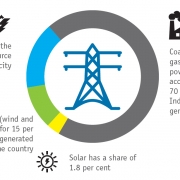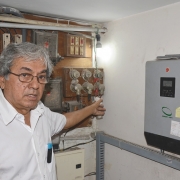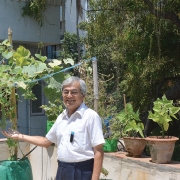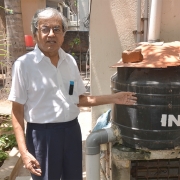
People
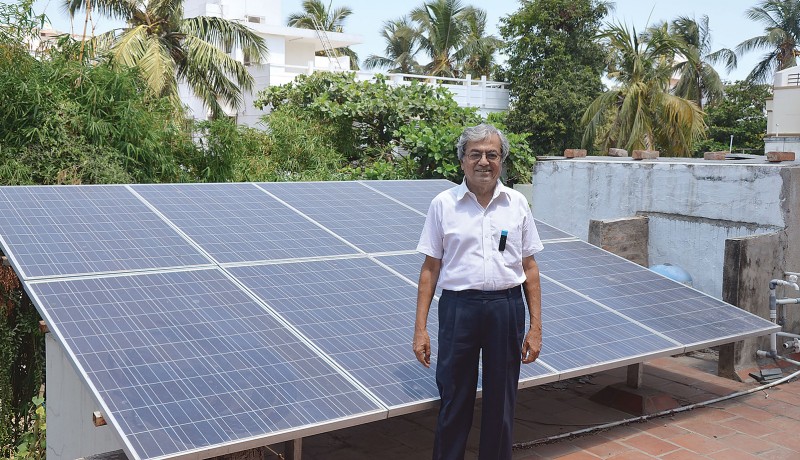
‘Solar’ Suresh from Chennai is helping people switch to a green source of energy, one kilowatt at a time, discovers Chitra Ramaswamy
When Cyclone Vardah made landfall in December last year, the city of Chennai plunged into darkness and went without water and electricity for five days. Yet one home remained unaffected. At their home in Kilpauk, D Suresh and his wife had electricity and even surplus running water. Why, they had enough to even help their neighbours. “Our friends and neighbours were charging their cell phones and filling water at our home,” recalls the 73 year-old.
Suresh’s home is an oasis of abundance in the centre of a city known for power cuts, scorching heat and erratic rain. Creepers wind themselves around tall bamboo trees that lean against the compound wall of his property, which houses a large, two-storey bungalow. And, here and there, you notice 15-inch circular pits fitted with pipes that channel stagnating water into the soil, so that the groundwater is regularly recharged.
The backyard of his home boasts a mini orchard, with mango, guava, gooseberry and custard apple trees scattered all over. Tucked neatly into a corner here is a small tank that makes up part of a rainwater harvesting system. An organic filtration system purifies the water through layers of pebble, charcoal and sand before it is stored in a sump. Elsewhere on the property, a larger tank announces ‘Biogas System’ in bold, white letters. However, the technology Suresh is most noted for—it has even earned him the nickname ‘Solar’ Suresh—lies in two sets of solar panels that gleam on an open terrace under the Chennai sun. It is this system that kept Suresh’s home running after the cyclone even as the city struggled to get back on its feet.
Suresh is a retired CEO, businessman and lecturer who is lending his knowledge on decentralised renewable energy systems to anyone willing to make the switch. In the past three years, he has directed the installation of solar power panels in three offices, six schools and seven households across Chennai, Hyderabad and Bengaluru. He also drove the installation of biogas plants in some residences in Chennai, in a retirement home in Hyderabad and kitchen gardens in Chennai.
Suresh’s own home is the product of a lifetime’s worth of experiences coupled with a series of fortunate events. One thing led to another over 20 years, finally transforming his home into a model system for the household.
As CEO of a textile company in Tamil Nadu, he frequently travelled to Germany for work, between 1987 and 1997. “I saw so many rooftop solar plants in a country that has a lot less sunshine than ours,” he recalls. Although the idea took firm root in his mind, it would be more than a decade before he could perfect the technique and find a vendor to install solar panels on his own terrace.
In the meantime, Suresh kept himself busy. He made a significant contribution to the reduction of waste generation at work. His work also took him on field trips to various regions in Gujarat. While travelling in Kutch, he noticed an abundance of rainwater harvesting systems in many residential colonies.
If he couldn’t set up his solar panels because India still didn’t have the technology, he decided to instead have a rainwater harvesting system installed at his home in Chennai. In 1997, after attending a presentation at a local Rotary Club meeting—given his IIT-IIM background, Suresh insisted on thoroughly understanding the mechanisms—he set it up at home.
By then, Suresh felt the time was right to act on his plans to install a solar power plant at his home, an initiative that would eventually define his public identity. Designing the system was the first step but more challenging was finding a suitable vendor for his custom-made project as the big players were not interested in projects involving a few kilowatts. He eventually did and, five years down the line, in January 2012, Suresh installed a 1kW solar power plant on the terrace of his bungalow.
“This was sufficient to power the lights, fans, TV, computer and a double-door refrigerator in my home,” he says. A year later, he added another panel of 2kW, and with the additional power thus generated he was able to also run a mixer, washing machine, air-conditioner and water pump. “By 2015, my entire house, except the water heater and oven, was running on solar power. Both these appliances require totally different technology,” he explains.
“It costs ₹ 80,000 to ₹ 100,000 to install a 1kW capacity system,” he reveals. Then, he asks, “When you buy a washing machine, air-conditioner, car or TV, do you calculate the return on investment? Then why do it for solar? Look at the comfort and convenience you enjoy! During the cyclone last year, people who sought our help to charge their mobiles and take water from our house marvelled at our solar system and made extensive enquiries on its working. They expressed a desire to install it in their terraces. Yet when the crisis passed, they forgot all about it.”
But over the years, word of Suresh’s solar installations have spread and enquiries for similar set-ups started coming in. So now he spends his time designing workable models for independent bungalows, apartments, hospitals, educational institutions, offices, factors and other businesses, free of charge, while setting up his customers with potential vendors, at least in cities where he has the contacts.
Bengaluru-based Kethan Maniar, a construction and packaging materials dealer, was one of his clients. With Suresh’s expertise, he installed 3kW solar panels at his office; with them, he runs eight computers, six fans and 20 LED lights. Satisfied with the result, he converted to solar at home a year later, all under Suresh’s supervision. “It was an incredible experience in terms of vastly reduced electricity bills,” he says. “Since the solar installation, we consume a lot more energy because we use all the modern gadgets—from a microwave oven to hairdryer, washing machine, three air-conditioners and a water pump. We live more comfortably now with reduced health problems. Besides, our medical bills too are lower now. My mother’s asthmatic bouts have eased and my wife, who is prone to migraine headaches especially after a hairwash, can freely use the dyer on her hair inspite of power cuts, thanks to the solar system.”
Hyderabad-based Kiran Mody, who generates 4,000 units of power a month, took Suresh’s help to install a 30kW solar system at his home in November 2016. “I have a two-storey bungalow and use most modern gadgets, including a microwave oven, a mixer-blender, water heater and six air-conditioners, besides lights and fans. So my monthly consumption is about 6,000 units. With the solar installation, I now save 70 per cent on electricity bills. As the panels are low-maintenance and have a life of 20-25 years, I am sure to get back my investment within five years.”
Indeed, Suresh jumps at the opportunity to introduce people to solar panels wherever he sees the potential. When his wife, an educational institute builder, published her book through Margham Publications in Chennai, he urged the proprietor, M Narayanan, to switch to solar at his printing press. So, with an 8kW installation that he put in place in June 2016, the proprietor generates 30 units a day and is able to meet half his monthly electricity needs. “The best part is that I do not shell out a rupee to maintain the panels, except to mop them every fortnight,” says Narayanan.
“People from Assam, Bhubaneswar, Rajasthan, Satara, Kolahpur and other places call me to install solar systems there. But I haven’t identified vendors in these places and the ones in Tamil Nadu are not inclined to travel outside the state to install them,” rues Suresh. In fact, he has taken his mission one step further by opening up his home to school students on field trips, delivering lectures in colleges and judging science presentations at educational institutes around Chennai. And when a child’s experiment catches his eye, he is quick to take them under his wing. Among a few students who he is mentoring is a Class 9 student who has developed a system to recover the heat produced by air-conditioners and refrigerators to generate electricity—right in Suresh’s ballpark!
For Suresh, interacting with young minds is an enriching experience as the questions come at him from the most unexpected of places. “When I made a 15-minute PowerPoint presentation at a primary school here in Chennai, a girl in Class 3 asked me how we would dispose of the panels once the solar system had expended its life. I was stunned at her grasp of the subject,” recalls Suresh in amazement. Rest assured, the silicon panels are recyclable.
THE ENERGY FACTSHEET
- India ranks highest among the top five off-grid solar markets in the world, according to the Off-Grid Business Indicator Report by the Solar Energy Foundation
- As per the Census of India 2011 and Wasteland Atlas of India 2011, the total solar power capacity in the country stands at 748 GW, which is more than twice of the country’s total installed power capacity
- According to a Bridge to India study, India’s total installed solar capacity has crossed the 10 GW mark, a major milestone for the sector
- The Ministry of New and Renewable Energy aims to achieve 100 GW solar capacity by 2022, comprising 40 GW rooftop and 60 GW large and medium-scale grid-connected projects
- Tamil Nadu has the highest installed capacity in the Indian solar market, followed by Rajasthan, Andhra Pradesh, Gujarat, Telangana, Madhya Pradesh and Punjab
- The world’s largest solar power plant spanning 10 sq km is situated at Kamuthi in Tamil Nadu. It packs 648 MW of power with a capacity to power 150,000 homes
- Bloomberg New Energy Finance reports that 91,000 households have been electrified by solar-powered devices, such as solar lanterns and off-grid home systems, as of March 2016
GO SOLAR
- Solar power is a natural, inexhaustible, non-polluting source of energy. In a word, it is unlimited, so you don’t need to watch your consumption
- The cost of installation is only a onetime investment; once recovered, solar energy is free
- A solar system requires low maintenance—cleaning once every six months
- Central and state governments offer subsidies for off-grid installation of solar panels by commercial enterprises
Photos: J Ramaswamy Featured in Harmony — Celebrate Age Magazine June 2017
AGRICULTURE
FORESTS
WILDLIFE
WATER
WASTE MANAGEMENT
SUSTAINABILITY
EXCLUSIVE COLUMN
EXCLUSIVE COLUMN
you may also like to read
-
For the love of Sanskrit
During her 60s, if you had told Sushila A that she would be securing a doctorate in Sanskrit in the….
-
Style sensation
Meet Instagram star Moon Lin Cocking a snook at ageism, this nonagenarian Taiwanese woman is slaying street fashion like….
-
Beauty and her beast
Meet Instagram star Linda Rodin Most beauty and style influencers on Instagram hope to launch their beauty line someday…..
-
Cooking up a storm!
Meet Instagram star Shanthi Ramachandran In today’s web-fuelled world, you can now get recipes for your favourite dishes at….



